From Eat the
Weeds and
other things, too
by Green Deane
Loquat: Get a
Grip on Grappa
Lovin' Loquats:
Eriobotryae japonicae
Newsletter 23 February 2021
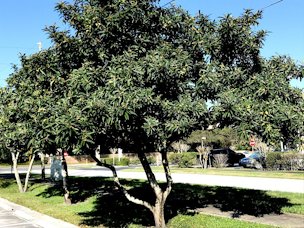
Loquats are starting to ripen
While driving around have you seen
a tree with large, dark green leaves and yellow fruit? It’s probably a
Loquat which are heavy with fruit now. This past Week I picked 10
pounds of Loquats in less than an hour. That’s calorie positive. Rather
than eating them outright I deseeded then dehydrated them. Like plums
changed to prunes the fruit changes character but it is still tasty. I
have also learned over the years at adding sulfur before drying does
not stop the fruit from browning. You can dehydrate tart and sweet
Loquats but you should avoid all green Loquats. Unripe fruit can be
toxic especially for children. As long as the fruit is yellow to gold
they are good. If you can detect any green hues the fruit is not ripe.
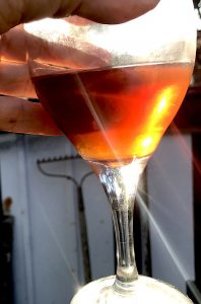
Year-old loquat wine
Loquats
are not native but they have naturalized themselves and can be found
throughout the region. How you eat the ripe fruit is something of a
debate. I just break off the stem that holds them to the tree then eat,
spitting out the seeds. You should try to not eat any seeds. An
occasional seed is of no great harm but they generally are not
considered edible though I have heard of folks roasting them then
eating them. I do not recommend that. Some people also peel the fruit
but I don’t. To dry them all I do is cut around the equator of a each
fruit, take out the seeds (used later to make into Loquat Grappa.) Then
dehydrate the fruit at about 130 F. I also made loquat wine
last
year during COVID april. It tastes similar to a dry semi-sweet sherry.
Lovin’
Loquats: Eriobotryae
Japonicae
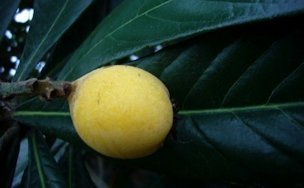
The fruit ripens from tart to very sweet
Long before there were couch potatoes there
were couch Loquats.
Loquats
are homebodies. Most people who live beyond the growing range of the
Loquat usually have never eaten a fresh one, having to settle for
canned representatives. Loquats just don’t travel well. They
bruise easily and loose their freshness quickly, much like a rose, its
distant relative. From the tree to the kitchen is almost the maximum
distance they will endure. Tree to tummy is the best. The state of
Florida says they will keep several weeks in the refrigerator, but my
experience is by then they look like large, lumpy raisins. 1
Although
called the Japanese Plum, the Loquat is not native to Japan nor is it a
plum. It’s extremely popular in Japan and has been cultivated
there for at least 1,000 years. Despite the name, the Loquat is
actually from southern China, where in Cantonese it is called Luh Kwat
(hence Loquat.) Translated that means “reed orange” or
“rush orange” or in other words it likes to grow where it
is wet. That seems more poetic than true because here in Florida they
grow where ever a bird drops the seed, wet or dry, hence they have
become naturalized. If you have a Loquat tree, you will have dozens of
Loquatlings. By the way, at least four different species of
fruit-eating bats also do their best to spread and fertilize Loquat
seeds.
1
In Mandarin Loquat is called “Pipa” because its shape
resembles a musical instrument, the Pipa, which is
pot-bellied like lute. In Japan the same mind set held sway
and
Loquat is called Biwa, after the musical instrument of the same shape.
Pipa/biwa, too close for pentatonic or verbal chance.
1
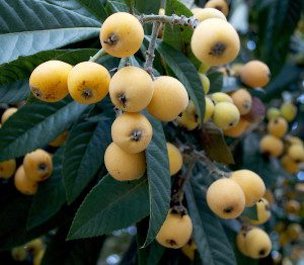
The Loquat
fruit is more like an apricot than a plum. It’s one of those
inexplicable linguisticism that in English we refer to Japan’s
apricot-like fruit as a “plum” but their plum
–ume—we call a Japanese apricot, which it is not. That does
not make a lot of sense. It makes you wonder if a couple of pages of an
early botany book book were transposed. Incidentally, the kumquat and
the Loquat are not related botanically, but both share an origin in old
Chinese names. Kumquat means “golden orange.” 1
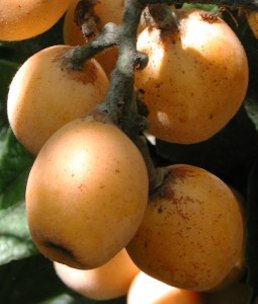
The
Loquat tree is unusual in that it blossoms in the fall or early winter,
and fruits in early winter or spring. Its blossoms were used
to
make perfumes in the 1950s. The quality of the perfume was said to be
outstanding, but the yield was low and not commercially viable. Some
individuals suffer headache when too close to a Loquat tree in bloom,
the aroma from the flowers sweet and penetrating. 1
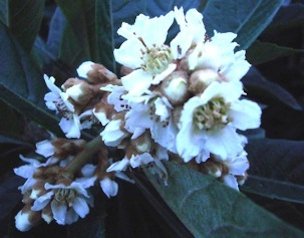
Loquats can bloom in the fall or early winter
My
Loquat tree blossoms around Christmas and I have edible fruit by St.
Valentine’s Day or St. Patrick’s Day. It varies. Loquats were
introduced to Florida in 1867 and the tree fruits as far
north as South Carolina. The wood is pink, hard, close-grained, and
medium-heavy. It is good for making rulers and bokkens. Bokkens? In
Japanese martial arts the practice sword — the bokken — was
often made of Loquat wood because it was hard but also brittle, perhaps
a realistic substitute for swords which then could be brittle. Legend
says a wound caused by a Loquat bokken will not heal and the victim
will die. There is no report of what happen to wounds caused by a
Loquat ruler in the hands of an old-fashion teacher, of which I had
several. 1

I planted my Loquat tree some 13 years ago and it has
been fruiting heavily for seven years. Following the suggestion of
local experts, the tree is pruned to resemble a bowl, which increases
production, up to 300 pounds of fruit a season. The sweet/tart yellow
pear-shaped fruit is a sign of winter, eh, or spring, depending upon
which cultivar you have. Many recipes are included below, or just use
apricot recipes. 1
Botanically in the same family with apples,
pears, peaches, nectarines et cetera, the Loquat‘s scientific
name is Eriobotryae
japonica (air-ee-oh-BOT-ree-uh juh-PAWN-ih-kuh).
Japonica means Japan and Eriobotryae is bastardized Greek — read
Latinized Greek — meaning “woolly bunch of
grapes.” Loquats grow on thick fuzzy stems in a cluster
like grapes. There is no controversy that the fruit is tasty. The
slippery seeds, however, are another issue. 1
Like many pome
members of the rose family, the seeds contain small amounts of
cyanogenetic glycosides. That’s almost as bad as it
sounds. Said
another way, in the gut this can make minute amounts of cyanide
that the body can tolerate. This is also known as amygdalin or
laetrile, also called B17, a controversial alternative medicine
treatment for cancer, usually obtained from apricot pips. This would
all be an almost dismissible interesting factoid if all we did was spit
the seeds out, or occasionally let an ingested whole seed go on its
merry alimentary way. But, then there is flavoring with the seeds,
roasting the seeds, and lastly, Loquat grappa, which is made from the
seeds. I should say, Loquat grappa is homemade. I know of no commercial
Loquat grappa. There are some Loquat-flavored liquors but they have a
different taste profile completely. They taste like Loquats. Loquat
grappa does not taste like Loquats.
1
Loquat
grappa is made by soaking Loquat seeds in vodka or grain alcohol for
one to six months and then adding sugar water to the infusion. The
longer you let it sit, the darker and stronger flavored it becomes. The
odd part is Loquat grappa made this way has a very strong cherry flavor
and aroma. Is Loquat grappa poisonous? That is a good
question.
Certain Indian tribes would leech cyanic glycosides out of seeds of
related plants then eat the ground up seeds. If the glycosides can been
leached out by water, then one would think vodka, which is half water,
would leech it from the seeds to the vodka, and alcohol is a good
solvent. Then again, it might not be chemically possible. If the toxin
is an oil — an acid — it might not mix with water or
alcohol. Perhaps a chemist will let us know. I can volunteer some
Loquat grappa for science. So while some toxicity would make
sense in some amount, it is an unknown. I’ve never seen
more than four ounces drank at a time. It seems to be tolerated at that
level, producing only expected effects. I make two
“fifths” a year of it and it lasts until the next
season. If you follow either of the Loquat grappa recipes
included below and make your own, you’re on your own: No
guarantees or promises of safety included. Consume sparingly. Oh,
adding a section of cinnamon bark to the final grappa bottle adds some
very nice flavor. 1
That said, the non-bitter roasted seeds are
reported to be tasty — I’m not sure I would eat one but
there are people who do, apparently — and some folks put a few
seeds in the cavity of a chicken before roasting to impart a nice
flavor. The roasted seeds when ground are said to be a good substitute
for coffee. (I think I’ll pass on that, for two reasons: One is
the debatable safety of the seeds. The other is every seed coffee
extender or substitute I’ve ever had is awful, including the
queen of substitutes, roasted ground persimmon seeds.) 1
Besides
amygdalin, the seeds also have lipids, sterol, b-sitosterol,
triglycerides, sterolester, diglycerides and compound lipids; and fatty
acids, mainly linoleic, palmitic, linolenic and oleic. Amygdalin is
also in the fruit peel, but slightly. The leaves possess a mixture of
triterpenes, also tannin, in addition, there are traces of
arsenic. (Arsenic And Old Loquat?) Young leaves contain saponin. The
leaves and seeds are also used in Chinese medicine, as is the fruit,
which has vitamins A, B, and C. The Loquat is still one of the most
popular cough remedies in the Orient, and is the ingredient of many
patent medicines.
1
One other warning: Do not eat a green,
uncooked Loquats. They taste awful and there is one case on record of
several stupefying a five-year old for two hours. Loquat pie
made
with greenish, not-quite-ripe fruit, however, supposedly taste like
cherry pie….1
Crows
and Bluejays
Newsletter 15 April 2014
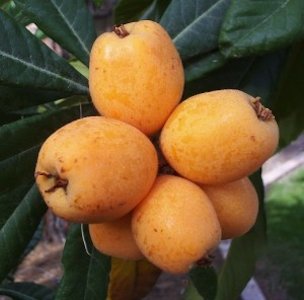
Loquats are ripe from when they are light yellow to deep
golden.
Crows
and Bluejays are closely related, and bright birds. This time of year
in Florida it is common to see flocks of crows presumably gathering for
a summer vacation flight north. I was out in the woods when a flock
dived bombed a distant tree. I had to find out what it was. But even
before I got there I could see crows flying off with golden yellow
fruit: Loquats. While a native of southeast Asia Loquats are
naturalized in Florida and the crows had chosen a well-fruited one. But
there was a method to their harvesting. Following the round crown of
the tree they picked fruit on top and down to the equator, leaving the
bottom rest. In other words they picked all over the top until they got
to where they would fall of. It left the loquat with a monk’s
haircut but left plenty for me for when I got there. I also suspect
that keeps them above most ground prey. 4
Recipes 1
Loquat
Grappa
Soak
one to two quarts of clean, whole Loquat seeds in a tight jar with a
quart of vodka for one to six months. At the end of soaking time, drain
the now flavored vodka and split it evenly between two fifth bottles.
On the stove create sugar water by mixing equal parts of sugar and
water. Heat until the sugar is dissolved. Top off each fifth with the
sugar water. If you want it less sweet use less sugar, or more vodka.
Loquat wine
4 lbs fresh loquats
2 lbs granulated sugar
1 tsp acid blend
1 gallon water
1 crushed Campden tablet
1/2 tsp pectic enzyme
1/2 tsp grape tannin
wine yeast and nutrient
Wash
fruit and remove seeds. Chop the fruit finely or roughly in a blender.
Pour fruit over half the sugar, crushed Campden tablet, tannin, yeast
nutrient, and enough water to total one gallon in primary, stirring
well to dissolve the sugar. Cover with cloth. After 12 hours, add
pectic enzyme and recover. After another 12 hours, add wine yeast and
recover. Stir daily, adding half the remaining sugar after three days.
Ferment on pulp another four days, stirring daily.
Strain
through nylon jelly bag and squeeze well to extract juice. Pour
remaining sugar into juice, juice into secondary, and fit airlock.
Siphon liquor off sediments into clean secondary after 30 days, topping
up as needed. Repeat racking every 30 days until wine clears (3-4
additional rackings). Rack once more and taste. If satisfied with
sweetness, bottle the wine. If too dry, add stabilizer and sweeten to
taste, adding up to 1/4 cup sugar dissolved in 1/4 cup
water. Age
Here is a
second Loquat grappa recipe from the internet.
Dry
200g of Loquat seeds in sun for a week. Put in a bottle with 400g
spirit grain alcohol, a piece of lemon rind and a piece of vanilla
bean. Keep covered in sun for 1 month, shaking it occasionally. Prepare
syrup of 300g sugar and 300g water. Boil, then when cool mix with
spirit, filter and bottle. Keep to season at least two months before
drinking.
And, Loquat
Jam
1 kg loquats, seeds removed but fruit not
peeled
200 ml water
Finely grated rind and juice of 2 lemons
Simmer
fruit in water till soft. mash well or put it through the blender. add
juice and rind and sugar; boil rapidly till a little sets on a cold
saucer. Bottle and seal.
More Loquat
Jam
Wash,
remove seeds, and blossom ends from whole ripe fruit. Run through food
chopper and measure pulp. Barely cover with cold water. Cook until
tender and deep red. Add 3/4 cup sugar to 1 cup of Loquat pulp. Cook
until thick, stirring constantly. Pour into hot sterilized jars and
seal with sterilized lids. It is best to cook small batches of no more
than 5 cups of fruit pulp in one kettle.
Loquat Jelly
With Pectin
5 lbs. ripe loquats
1 cup water
1/2 cup lemon juice 1 package pectin
5-1/2 cups sugar
Gather
Loquats when full size. Wash, remove seeds, and blossom ends. Barely
cover with cold water. Simmer covered for 15 minutes Cook slowly until
pulp is very soft. Strain juice through jelly bag. Measure 3-1/2 cups
Loquat juice and lemon juice in a large kettle. if more juice is
needed, fill last cup or fraction of a cup with water. Add pectin. Stir
well. Place over high heat and bring to boil, stirring constantly. Add
the sugar and mix well. Continue stirring and bring to full rolling
boil. Boil exactly 2 minutes. Remove from fire and let boiling subside.
Skim carefully. Pour into hot sterilized jelly glasses, leaving
1/2-inch space at top to cover at once with melted paraffin. (Or pour
into hot sterilized jars and seal with sterilized lids.)
Loquat Jelly
No Added Pectin
Gather
Loquats when full size. Wash, remove seeds, and blossom ends. Barely
cover with cold water. Cook slowly until pulp is very soft. Strain
through jelly bag. Drain and cook until juice is thick then add an
equal amount of sugar. Boil rapidly to jelly stage. Pour into
sterilized jelly glasses, leaving 1/2-inch space at top to cover at
once with melted paraffin. (Or pour into hot sterilized jars and seal
with sterilized lids.)
Spiced Loquats
For
three pints of sweet pickles, wash three pounds of firm loquats and
remove the stem and blossom ends; do not peel them. Drop them into the
pickling syrup given below and cook until tender. Remove the fruit.
Pour remaining syrup into sterilized jars. Fill almost to overflowing
with the hot syrup and seal at once.
3 cups sugar
1-1/2 cups water
1-1/2 cups cider vinegar
1 tablespoon whole cloves
1 tablespoon whole allspice
2-inch stick of cinnamon
Combine
sugar, water, and vinegar in a large kettle. Tie the spices loosely in
cheesecloth and add. Boil 10 minutes. Put in fruit and cook gently
until tender. This syrup may be used for apricots, peaches, pears,
apples, crab apples, plums, loquats, and kumquats
Loquat Chutney
Use the kiwi fruit chutney recipe, but
substitute peeled, seeded loquats for kiwi fruit
Blanched
Loquats
To
peel loquats for sauce and fruit cup, blanch by pouring boiling water
over loquats to cover. Add 1/4 cup lemon juice to each quart of water.
Cook over low heat about 5 minutes, just until skin loosen. Drain and
reserve liquid. Cool, peel, halve, and seed loquats (remove seeds).
Loquat Sauce
for Ice Cream
Combine
two cups juice from blanched loquats with two cups sugar. (see
Blanching above) Bring to boil, cook over medium heat until syrup spins
a two-inch thread when dropped from a spoon (230 degrees to 234 degrees
Farenheit on candy thermometer), about 20 minutes. Cool completely. Add
two cups peeled, halved, seeded loquats. Chill, then serve over ice
cream. Makes about three cups sauce.
Sugar and
Spice Loquats
Sprinkle
seeded (peeled if you want) fruit with granulated sugar. Mix cream
cheese with powdered sugar and cinnamon and put in cavity. Top with a
cut piece of strawberry.
BLOG NOTE: I have made the following pie without seeds and it it is
quite
tasty.
Loquat Pie
8 cups loquats
1/2 cup water
1 cup sugar
3 tablespoons flour
1/4 teaspoon salt
1/8 teaspoon ginger
1/8 teaspoon allspice
pastry for a double crust pie
Stem,
wash and cut up loquats, leaving a few seeds for flavor, (When the pie
is baked, the seeds taste almost like nuts and are really very
good). Cook the loquats in water, covered, for about 10
minutes
or until almost tender.
Combine the sugar, flour, salt, ginger and
allspice. Stir in the loquats. Cook, stirring,
until
thickened. Remove from the heat and cool.
Pour into a pie
plate containing the bottom pie crust. Cover with the top
crust
and prick with a fork or put a few cuts in the top crust to allow steam
to escape while baking.
Bake at 450 degrees “F” for 10 minutes, then reduce the heat to 350
degrees “F” for another 45 minutes.
Cool and serve with Vanilla bean ice-cream, and a light rum
sauce..
The
following recipes come from Marian Van Atta, whom I knew in the early
80’s. She had a newspaper column called Living off the Land. She
looked home-spun and back to nature long before it was posh, a portly
Mom Nature. She has a book, also available at Amazon: “Exotic
Foods, a Kitchen and Garden Guide.” Here is the link: http://www.amazon.com/exec/obidos/ASIN/1561642150/californirarefru
Fresh Loquat
Relish
1 cup of loquats, cut in half and seeded
2 or three calamondins (quartered and seeded)
1/4 cup honey
1 tablespoon lemon juice
1/2 cup raisins
Put
all ingredients in a blender and chop for a minute or so. Put in a
covered jar and store in the refrigerator. Will last at least a week.
Martha’s
Loquat Pie
3 cups loquats, seeded and sliced
3/4 cups sugar, less if fruit is very ripe
2 tablespoons flour.
Mix
loquats, sugar and flour together. Put in unbaked 9-inch pie crust.
Cover with top crust and slash for steam vents. Bank at 400 degrees for
10 minutes. Reduce to 350 degrees. Bake until crust is browned, about
35 more minutes.
Drying Loquats
Newsletter 26 March 2013
Newsletter 19 Feb. 2013
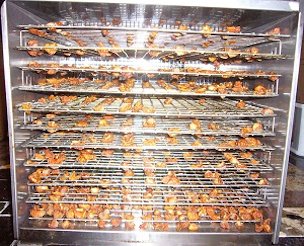
Dehydrated loquats take on a sweet/sour flavor
Cut in half, remove seeds, prick skin with
fork, dry accordingly.
Loquats,
planted and naturalized, are a much-anticipated tasty fruit that do not
travel well. One rarely sees them in local markets. They bruise easily
and begin to lose their bright yellow color within hours of picking.
The refrigerator does not treat them well, either. While loquats can be
canned I think the best way to preserve this bounty is by dehydration.
I cut around the fruit’s equator, remove the seeds for other use,
then dry the two halves. Some people dip the halves in a sulfur
solution first but I have not found that to improve looks, flavor or
preservation. The reason why I recommend dehydrating them is you end up
with a delicious product. Some fruits do not dehydrate well, loosing
flavor and or texture. Mulberries are a good example. They are best
fresh. And while dried loquats don’t taste like fresh loquats
— as prunes don’t taste like plums — they are good
dehydrated and store well. 3
Drying
them creates a different product but they’re still tasty and
interesting. The question is what to call these dried loquats?
Dryquats? Sunquats? Squats? We are in the middle of loquat season here
in Central Florida and my dehydrator is working day and night.
Mine’s an industrial brute of stainless steel (and despite
descriptions to the contrary it is not quiet.) Here’s 16 pounds
of seeded loquats coming out of the dehydrator reduced to three pounds.
2
Loquat Food
Value Per 100 g of Edible Portion1
Calories 168
Protein 1.4 g
Fat 0.7 g
Carbohydrates 43.3 g
Calcium 70 mg
Phosphorus 126 mg
Iron 1.4 mg
Potassium 1,216 mg
Vitamin A 2,340 I.U.
Ascorbic Acid 3 mg
Green Deane’s
“Itemized” Plant Profile
1
Identification: Evergreen
large shrub or small tree, rounded crown, short trunk, woolly new
twigs. Leaves alternate, simple, 10-25 cm long, dark green, tough,
leathery, toothed edge, velvety-hairy below.
Time of Year:
Culitvars vary, some fruit in spring, some fruit in late summer or fall.
Environment:
It likes heat and full sun, will survive said if watered.
Naturalized in many areas.
Method of
Preparation: Yellow fruit raw or cooked, seeds can be used
to make a cherry-flavored liquor.
Disclaimer
from Green Deane
Information contained on this website is strictly and
categorically intended as a reference to be used in conjunction with
experts in your area. Foraging should never begin without the guidance
and approval of a local plant specialist. The providers of this website
accept no liability for the use or misuse of information contained in
this website.
Back to
Loquat
Page
|
|








